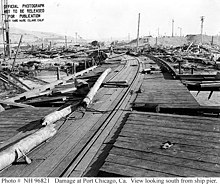Port Chicago Naval Magazine National Memorial
38°3′27″N 122°1′47″W / 38.05750°N 122.02972°W / 38.05750; -122.02972

The Port Chicago Naval Magazine National Memorial is a memorial dedicated in 1994 recognizing the dead of the Port Chicago disaster, and the critical role played by Port Chicago, California during World War II, in serving as the main facility for the Pacific Theater of Operations. The national memorial is located at the Concord Naval Weapons Station near Concord, California, in the United States.
The 1944 Port Chicago disaster occurred at the naval magazine and resulted in the largest domestic loss of life during World War II. A total of 320 sailors and civilians were instantly killed on July 17, 1944, when the ships they were loading with ammunition and bombs exploded. The majority of the deaths were African American sailors working for the racially segregated military. The explosion and its aftermath led to the largest Naval mutiny in US history, and it and the subsequent trial became major catalysts for the United States Navy to desegregate following the war.[3]
History
The national memorial, administered by the National Park Service, was authorized by Pub. L.Tooltip Public Law (United States) 102–562 on October 28, 1992. The memorial was dedicated in 1994 and is located on the grounds of the Military Ocean Terminal Concord (MOTCO), formerly the Tidal Area of the Concord Naval Weapons Station. The memorial is only open to the public through reserved guided tours. On October 28, 2009, the Memorial became an official unit of the National Park System.
Plans
The Port Chicago Committee is working toward expanding the current memorial to encompass 250 acres (1.0 km2) of the former Port Chicago waterfront. The memorial site could include some of the railroad revetments and old boxcars from the 1940s period, as well as the existing memorial chapel, with stained-glass windows depicting the World War II operations.[citation needed]
See also
- Other Navy memorials
- Rosie the Riveter/World War II Home Front National Historical Park
- List of national memorials of the United States
References
- ^ "Listing of acreage – December 31, 2011" (XLSX). Land Resource Division, National Park Service. Retrieved March 23, 2012. (National Park Service Acreage Reports)
- ^ "NPS Annual Recreation Visits Report". National Park Service. Retrieved March 23, 2012.
- ^ National Park Service. "People - Port Chicago Naval Magazine National Memorial (U.S. National Park Service)". www.nps.gov. Retrieved July 18, 2023.
- The National Parks: Index 2001–2003. Washington: U.S. Department of the Interior.
- Press Release. Port Chicago Naval Magazine National Memorial Becomes 392nd Unit of National Park System
External links
 Media related to Port Chicago Naval Magazine National Memorial at Wikimedia Commons
Media related to Port Chicago Naval Magazine National Memorial at Wikimedia Commons
- Official NPS website: Port Chicago Naval Magazine National Memorial
- Port Chicago Committee
- v
- t
- e
| |||||||||||||||||
National Forests and Grasslands | |||||||
|---|---|---|---|---|---|---|---|
| |||||||
|
| |||||||
| |||||||
|
|
- Heritage registers
- National Natural Landmarks











